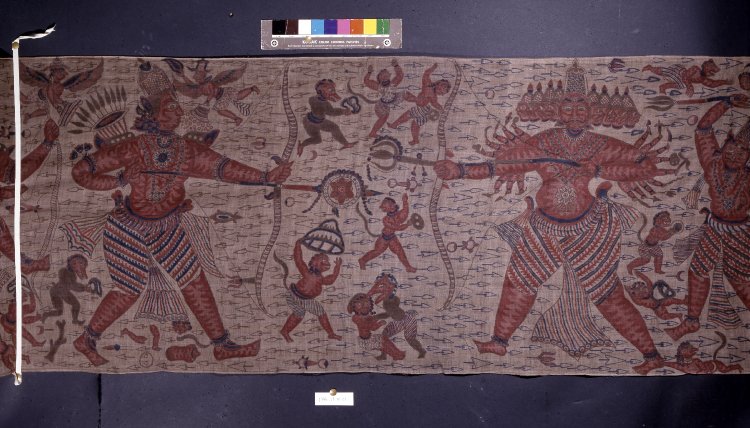by Ilyse R. Morgenstein Fuerst
Our class on the Ramayana focused on intensive reading (1,200+ pages) and genealogies, which is to say, how the Ramayana is read, translated, retranslated, and applied in popular practice, political movements, and in local vernaculars.
As the professor for REL131, I’m proud of the work that this blog contains. Each post is the product of a semester-long research project, which started as a question, moved toward a full bibliography drawing upon in-class and outside sources, multiple drafts, and finally, what you see here. You’ll notice, of course, that most students have written on differing subjects, and even those that chose the same topic (Sita was a fan favorite!) do not approach it in the same way.

Textile. Painted cotton-cloth textile showing the battle between Rama and Ravana. From British Museum.
I’ve asked that students write short blogposts, instead of long research papers–though, admittedly, while they’ve produced the former, they’ve done the work required of the latter. The truth is, learning to be engaging, be pointed, and be finished in one’s writing is–in my experience as both a professor and a writer–far, far harder than learning to stretch, to fill, to offer more sources and more data. I’ve asked students to do high-level research, but keep their comments brief; their work reflects what research projects look like beyond academia: lots of work, lots of details, lots of data, and a short presentation.
Pedagogically, I’ve not only been impressed by the quality of questions, I’ve been impressed by the ways in which students have revised their ideas. Robert Graves quipped that there is no great writing, just great rewriting–and while many faculty members come to know this (sometimes painful) truth as part of our publishing process and obligations, it is a hard lesson to impart to our students. Or, I should say, the value of the rewrite, despite its pain and inherent demand of humility, is a hard lesson for me to teach. But a valuable one, both in and outside the college classroom. I must say, REL131 has swallowed lessons of multiple drafts, peer review, and rewriting with surprising poise. To boot, I’ve noticed students’ in-class contributions reflect their ongoing research projects, and discussions have been richer for it. Our blog-as-research project is a success for these reasons.
With that opening, I invite you, dear reader, to click around. Welcome to a slice of REL131: Studies in Hindu Traditions.
